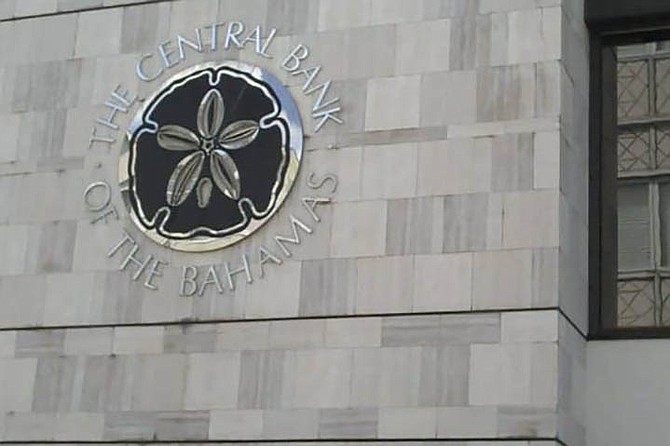By NEIL HARTNELL
Tribune Business Editor
nhartnell@tribunemedia.net
The Bahamas’ national debt has seen its first quarterly decline for years as it fell by just over $30m during the three-months to end-March 2019 thanks to a small budget surplus.
The Central Bank’s quarterly review for the period, published this week, disclosed: “At end-March, the national debt - inclusive of contingent liabilities - declined by $30.1m (0.4 percent) over the prior quarter to $8.186bn, but strengthened by $277.3m (3.5 percent) vis-à-vis March 2018.”
One quarterly decline does not represent a trend, and the level of increase over the prior year indicates much more work remains to be done, but the quarterly reduction in The Bahamas’ “red ink” is a potential sign that the Government is beginning to arrest the rate of growth in the $8bn-plus national debt.
The size of the national debt, as a percentage of Bahamian economic output, also remains some distance away from the Fiscal Responsibility Act’s 50 percent debt-to-GDP target. “As a ratio, the direct charge [on government] fell by an estimated 20 basis points on a quarterly basis, but rose by 2.2 percentage points year-on-year to 60.2 percent at end-March,” the Central Bank said.
“In addition, the national debt-to-GDP ratio narrowed to an estimated 65.9 percent from 66.1 percent in the previous three-month period, while in comparison to the prior year the ratio firmed by 2.2 percentage points.”
The national debt reduction was driven by a “modest” $40m surplus for the first three calendar months of 2019, a period that is traditionally the Government’s greatest revenue earner as it coincides with peak economic activity stemming from the winter tourism season, payment of Business Licence fees, the bulk of real property tax receipts and commercial vehicle licensing month.
“Buoyed by the increase in VAT receipts following the 4.5 percentage point hike in the rate to 12 percent in prior periods, the Government’s revenue firmed by $88.3m (15 percent) to $677.4m in the third quarter of fiscal year 2018-2019, outstripping the $36.5m (6.1 percent) increase in aggregate expenditure to $637.5m,” the Central Bank said.
However, it also highlighted in a separate report the continued growth struggles of the Bahamian financial services industry amid the constant barrage of international regulatory initiatives from the likes of the European Union (EU) and Organisation for Economic Co-Operation and Development (OECD).
“Given entities’ ongoing efforts to outsource operations and consolidate business lines, employment within the banking sector has been on a declining trend,” the Central Bank said. “Specifically, survey data showed that total employment declined by 80 (1.9 percent) to approximately 4,049 persons in 2018, after a 3 percent fall-off a year earlier, and an average 3.6 percent contraction over the 2013-2017 period.
“In particular, the number of Bahamian employees decreased by 62 (1.6 percent) to 3,800, while the non-Bahamian segment fell by 18 (6.7 percent) to 249. As a consequence, the share of Bahamian employees in the sector edged up by 32 basis points to 93.9 percent at end-December, vis-à-vis the same period in 2017, while the share of the non-Bahamian component declined to 6.1 percent.”
The Central Bank added that total assets in the Bahamian international banking sector had fallen by 9.8 percent over the past five years as institutions “continued to consolidate their operations amid declining business prospects”. They decreased in 2108 by 1.4 percent to $166.1bn, a reversal from a 2.1 percent increase in 2017.
“The total domestic assets of the banking sector declined by 2.4 percent to $10bn in 2018, a reversal from a 2.3 percent expansion in the previous year and an average 1.2 percent increase over the previous five years,” the Central Bank said, “as banks’ deposits with the Central Bank and holdings of Government securities contracted by 21.7 percent and 5.1 percent, respectively.”
The Central Bank continued: “The total number of banks and trust companies licensed in The Bahamas declined by 11 to 231 in 2018, following a decrease of six in the prior year. The largest reduction occurred in the restricted, non-active and nominee licensees’ category by 10 to 142, while the number of public banks and trust companies decreased by just one to 89.
“At end-December, public licensees consisted of 54 Bahamian incorporated entities, 15 euro-currency branches of foreign banks, 12 authorised agents (trust companies) and 8 authorised dealers (commercial banks).”




Comments
Well_mudda_take_sic 4 years, 9 months ago
LMAO at the temporary small reduction compared to the tidal wave of announced planned additions to our national debt.
Sign in to comment
Or login with:
OpenID